Report: Analysis of Health Workforce Shortage and Recommendations
VerifiedAdded on 2022/09/27
|8
|2034
|31
Report
AI Summary
This report addresses the critical issue of health workforce shortages in the medical field, focusing on Australia's situation. It explores the causes, including low student interest, perceived difficulty of medical training, and inadequate remuneration, leading to a shortage of healthcare professionals. The report analyzes the impacts, such as reduced quality of care and longer patient wait times, and proposes recommendations to encourage medical education, improve medical remuneration, and involve stakeholders. It suggests systematic implementation through a task force, communication plans, and clear timeframes to increase the number of healthcare workers and improve patient outcomes. The report also emphasizes the financial implications and the need for government and stakeholder collaboration to address the issue effectively. The success of the recommendations will be measured by the number of people awaiting medical attention and the number of students pursuing medical professions. This report provides a comprehensive analysis of the health workforce shortage and proposes practical solutions to improve healthcare delivery.
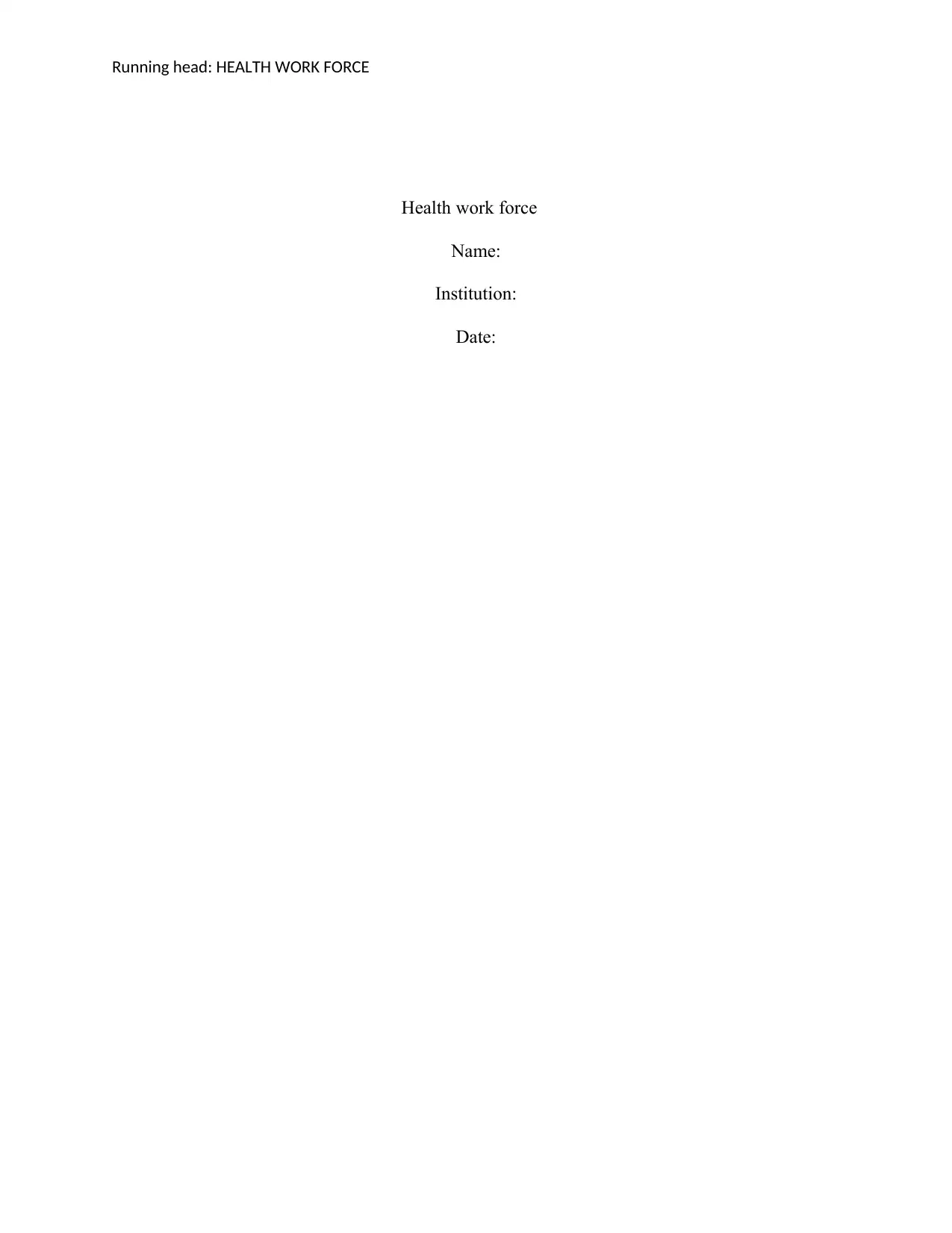
Running head: HEALTH WORK FORCE
Health work force
Name:
Institution:
Date:
Health work force
Name:
Institution:
Date:
Paraphrase This Document
Need a fresh take? Get an instant paraphrase of this document with our AI Paraphraser
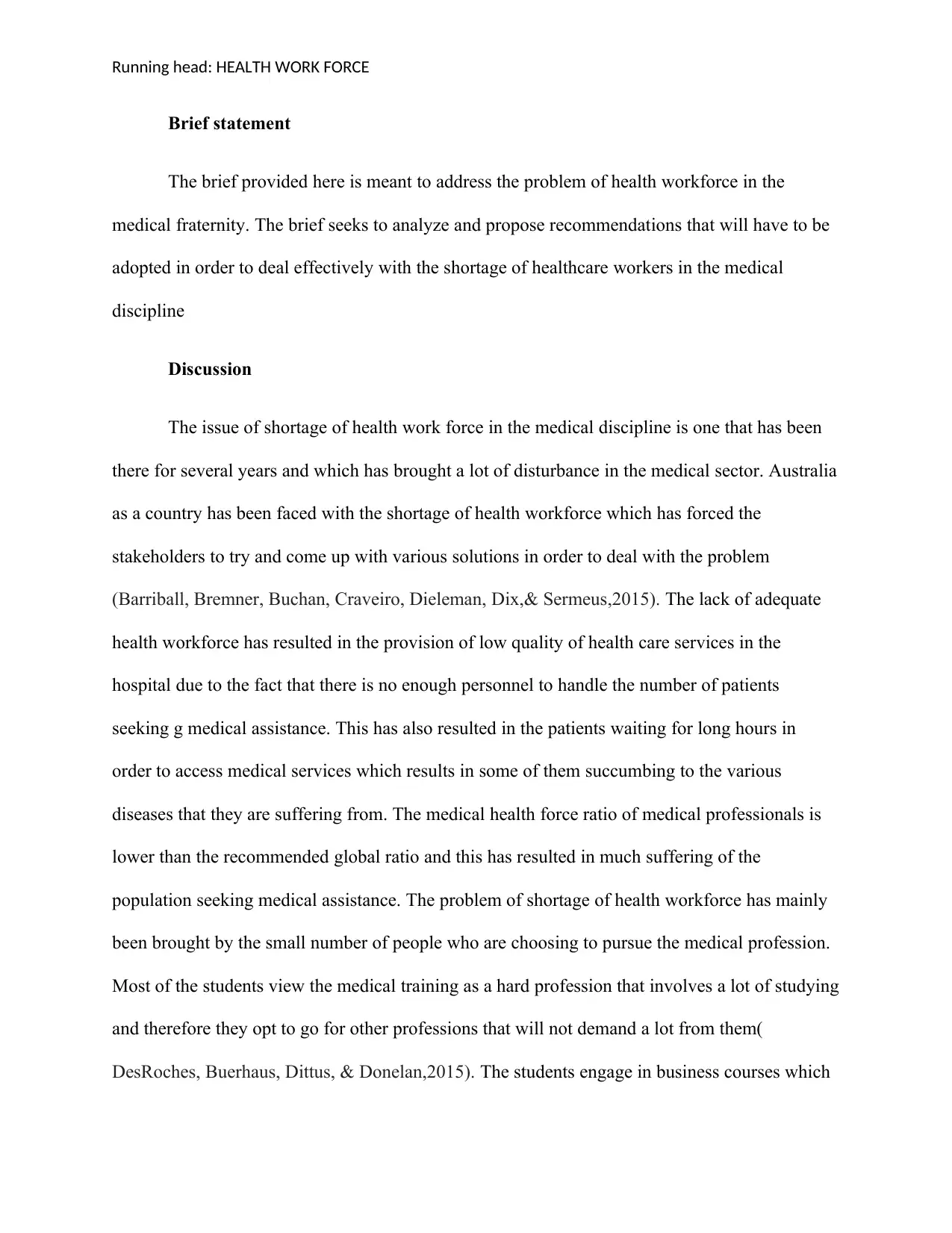
Running head: HEALTH WORK FORCE
Brief statement
The brief provided here is meant to address the problem of health workforce in the
medical fraternity. The brief seeks to analyze and propose recommendations that will have to be
adopted in order to deal effectively with the shortage of healthcare workers in the medical
discipline
Discussion
The issue of shortage of health work force in the medical discipline is one that has been
there for several years and which has brought a lot of disturbance in the medical sector. Australia
as a country has been faced with the shortage of health workforce which has forced the
stakeholders to try and come up with various solutions in order to deal with the problem
(Barriball, Bremner, Buchan, Craveiro, Dieleman, Dix,& Sermeus,2015). The lack of adequate
health workforce has resulted in the provision of low quality of health care services in the
hospital due to the fact that there is no enough personnel to handle the number of patients
seeking g medical assistance. This has also resulted in the patients waiting for long hours in
order to access medical services which results in some of them succumbing to the various
diseases that they are suffering from. The medical health force ratio of medical professionals is
lower than the recommended global ratio and this has resulted in much suffering of the
population seeking medical assistance. The problem of shortage of health workforce has mainly
been brought by the small number of people who are choosing to pursue the medical profession.
Most of the students view the medical training as a hard profession that involves a lot of studying
and therefore they opt to go for other professions that will not demand a lot from them(
DesRoches, Buerhaus, Dittus, & Donelan,2015). The students engage in business courses which
Brief statement
The brief provided here is meant to address the problem of health workforce in the
medical fraternity. The brief seeks to analyze and propose recommendations that will have to be
adopted in order to deal effectively with the shortage of healthcare workers in the medical
discipline
Discussion
The issue of shortage of health work force in the medical discipline is one that has been
there for several years and which has brought a lot of disturbance in the medical sector. Australia
as a country has been faced with the shortage of health workforce which has forced the
stakeholders to try and come up with various solutions in order to deal with the problem
(Barriball, Bremner, Buchan, Craveiro, Dieleman, Dix,& Sermeus,2015). The lack of adequate
health workforce has resulted in the provision of low quality of health care services in the
hospital due to the fact that there is no enough personnel to handle the number of patients
seeking g medical assistance. This has also resulted in the patients waiting for long hours in
order to access medical services which results in some of them succumbing to the various
diseases that they are suffering from. The medical health force ratio of medical professionals is
lower than the recommended global ratio and this has resulted in much suffering of the
population seeking medical assistance. The problem of shortage of health workforce has mainly
been brought by the small number of people who are choosing to pursue the medical profession.
Most of the students view the medical training as a hard profession that involves a lot of studying
and therefore they opt to go for other professions that will not demand a lot from them(
DesRoches, Buerhaus, Dittus, & Donelan,2015). The students engage in business courses which
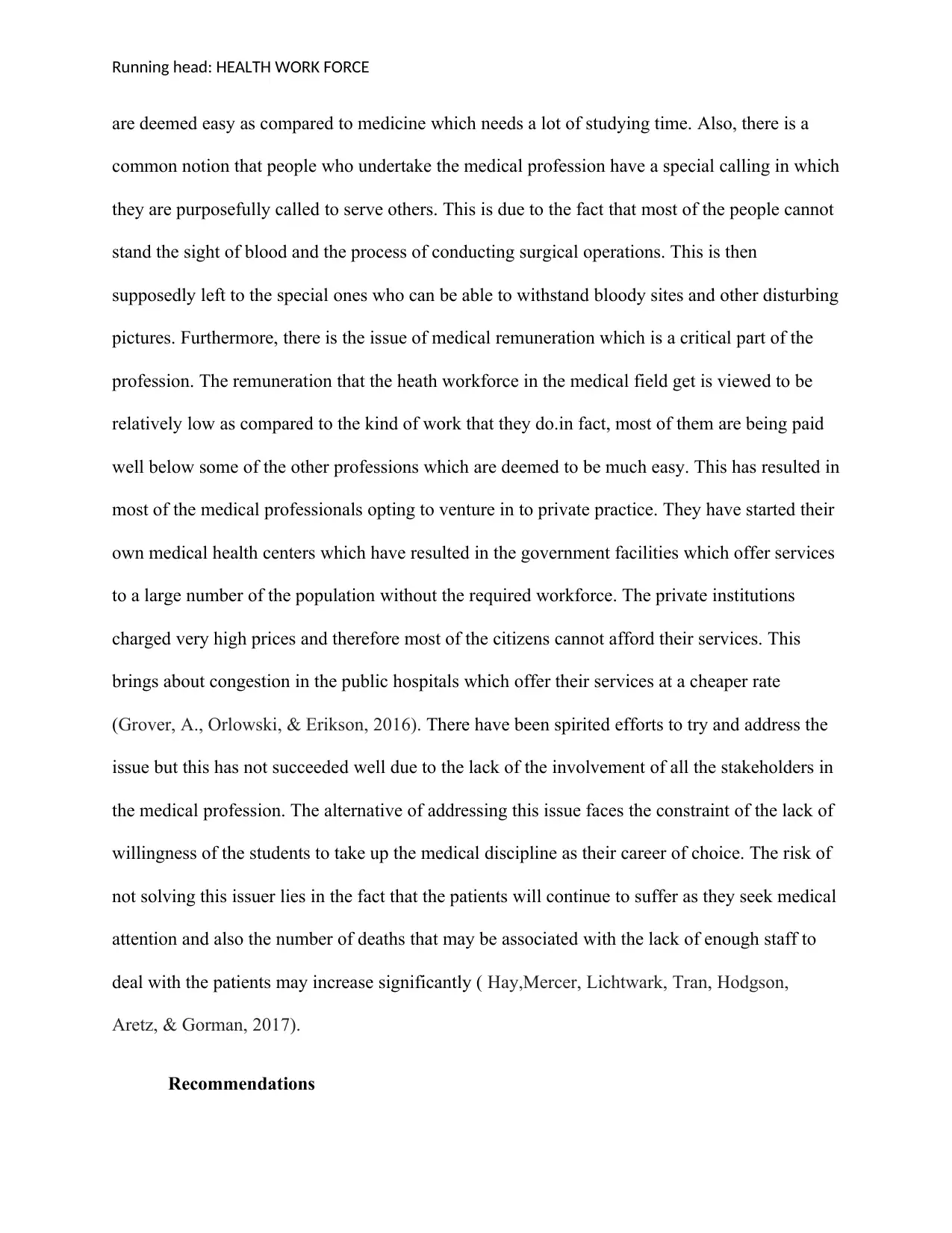
Running head: HEALTH WORK FORCE
are deemed easy as compared to medicine which needs a lot of studying time. Also, there is a
common notion that people who undertake the medical profession have a special calling in which
they are purposefully called to serve others. This is due to the fact that most of the people cannot
stand the sight of blood and the process of conducting surgical operations. This is then
supposedly left to the special ones who can be able to withstand bloody sites and other disturbing
pictures. Furthermore, there is the issue of medical remuneration which is a critical part of the
profession. The remuneration that the heath workforce in the medical field get is viewed to be
relatively low as compared to the kind of work that they do.in fact, most of them are being paid
well below some of the other professions which are deemed to be much easy. This has resulted in
most of the medical professionals opting to venture in to private practice. They have started their
own medical health centers which have resulted in the government facilities which offer services
to a large number of the population without the required workforce. The private institutions
charged very high prices and therefore most of the citizens cannot afford their services. This
brings about congestion in the public hospitals which offer their services at a cheaper rate
(Grover, A., Orlowski, & Erikson, 2016). There have been spirited efforts to try and address the
issue but this has not succeeded well due to the lack of the involvement of all the stakeholders in
the medical profession. The alternative of addressing this issue faces the constraint of the lack of
willingness of the students to take up the medical discipline as their career of choice. The risk of
not solving this issuer lies in the fact that the patients will continue to suffer as they seek medical
attention and also the number of deaths that may be associated with the lack of enough staff to
deal with the patients may increase significantly ( Hay,Mercer, Lichtwark, Tran, Hodgson,
Aretz, & Gorman, 2017).
Recommendations
are deemed easy as compared to medicine which needs a lot of studying time. Also, there is a
common notion that people who undertake the medical profession have a special calling in which
they are purposefully called to serve others. This is due to the fact that most of the people cannot
stand the sight of blood and the process of conducting surgical operations. This is then
supposedly left to the special ones who can be able to withstand bloody sites and other disturbing
pictures. Furthermore, there is the issue of medical remuneration which is a critical part of the
profession. The remuneration that the heath workforce in the medical field get is viewed to be
relatively low as compared to the kind of work that they do.in fact, most of them are being paid
well below some of the other professions which are deemed to be much easy. This has resulted in
most of the medical professionals opting to venture in to private practice. They have started their
own medical health centers which have resulted in the government facilities which offer services
to a large number of the population without the required workforce. The private institutions
charged very high prices and therefore most of the citizens cannot afford their services. This
brings about congestion in the public hospitals which offer their services at a cheaper rate
(Grover, A., Orlowski, & Erikson, 2016). There have been spirited efforts to try and address the
issue but this has not succeeded well due to the lack of the involvement of all the stakeholders in
the medical profession. The alternative of addressing this issue faces the constraint of the lack of
willingness of the students to take up the medical discipline as their career of choice. The risk of
not solving this issuer lies in the fact that the patients will continue to suffer as they seek medical
attention and also the number of deaths that may be associated with the lack of enough staff to
deal with the patients may increase significantly ( Hay,Mercer, Lichtwark, Tran, Hodgson,
Aretz, & Gorman, 2017).
Recommendations
⊘ This is a preview!⊘
Do you want full access?
Subscribe today to unlock all pages.

Trusted by 1+ million students worldwide
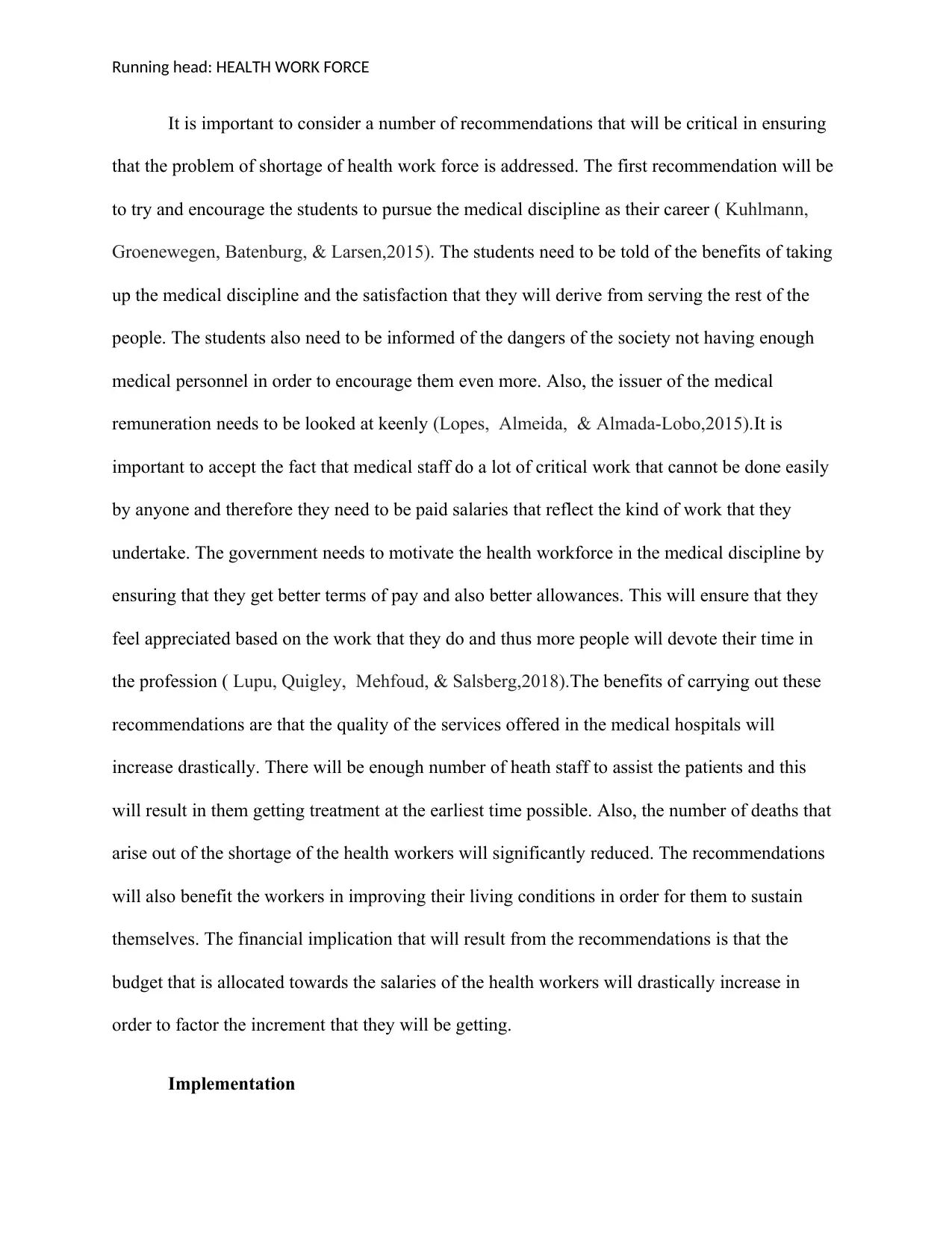
Running head: HEALTH WORK FORCE
It is important to consider a number of recommendations that will be critical in ensuring
that the problem of shortage of health work force is addressed. The first recommendation will be
to try and encourage the students to pursue the medical discipline as their career ( Kuhlmann,
Groenewegen, Batenburg, & Larsen,2015). The students need to be told of the benefits of taking
up the medical discipline and the satisfaction that they will derive from serving the rest of the
people. The students also need to be informed of the dangers of the society not having enough
medical personnel in order to encourage them even more. Also, the issuer of the medical
remuneration needs to be looked at keenly (Lopes, Almeida, & Almada-Lobo,2015).It is
important to accept the fact that medical staff do a lot of critical work that cannot be done easily
by anyone and therefore they need to be paid salaries that reflect the kind of work that they
undertake. The government needs to motivate the health workforce in the medical discipline by
ensuring that they get better terms of pay and also better allowances. This will ensure that they
feel appreciated based on the work that they do and thus more people will devote their time in
the profession ( Lupu, Quigley, Mehfoud, & Salsberg,2018).The benefits of carrying out these
recommendations are that the quality of the services offered in the medical hospitals will
increase drastically. There will be enough number of heath staff to assist the patients and this
will result in them getting treatment at the earliest time possible. Also, the number of deaths that
arise out of the shortage of the health workers will significantly reduced. The recommendations
will also benefit the workers in improving their living conditions in order for them to sustain
themselves. The financial implication that will result from the recommendations is that the
budget that is allocated towards the salaries of the health workers will drastically increase in
order to factor the increment that they will be getting.
Implementation
It is important to consider a number of recommendations that will be critical in ensuring
that the problem of shortage of health work force is addressed. The first recommendation will be
to try and encourage the students to pursue the medical discipline as their career ( Kuhlmann,
Groenewegen, Batenburg, & Larsen,2015). The students need to be told of the benefits of taking
up the medical discipline and the satisfaction that they will derive from serving the rest of the
people. The students also need to be informed of the dangers of the society not having enough
medical personnel in order to encourage them even more. Also, the issuer of the medical
remuneration needs to be looked at keenly (Lopes, Almeida, & Almada-Lobo,2015).It is
important to accept the fact that medical staff do a lot of critical work that cannot be done easily
by anyone and therefore they need to be paid salaries that reflect the kind of work that they
undertake. The government needs to motivate the health workforce in the medical discipline by
ensuring that they get better terms of pay and also better allowances. This will ensure that they
feel appreciated based on the work that they do and thus more people will devote their time in
the profession ( Lupu, Quigley, Mehfoud, & Salsberg,2018).The benefits of carrying out these
recommendations are that the quality of the services offered in the medical hospitals will
increase drastically. There will be enough number of heath staff to assist the patients and this
will result in them getting treatment at the earliest time possible. Also, the number of deaths that
arise out of the shortage of the health workers will significantly reduced. The recommendations
will also benefit the workers in improving their living conditions in order for them to sustain
themselves. The financial implication that will result from the recommendations is that the
budget that is allocated towards the salaries of the health workers will drastically increase in
order to factor the increment that they will be getting.
Implementation
Paraphrase This Document
Need a fresh take? Get an instant paraphrase of this document with our AI Paraphraser
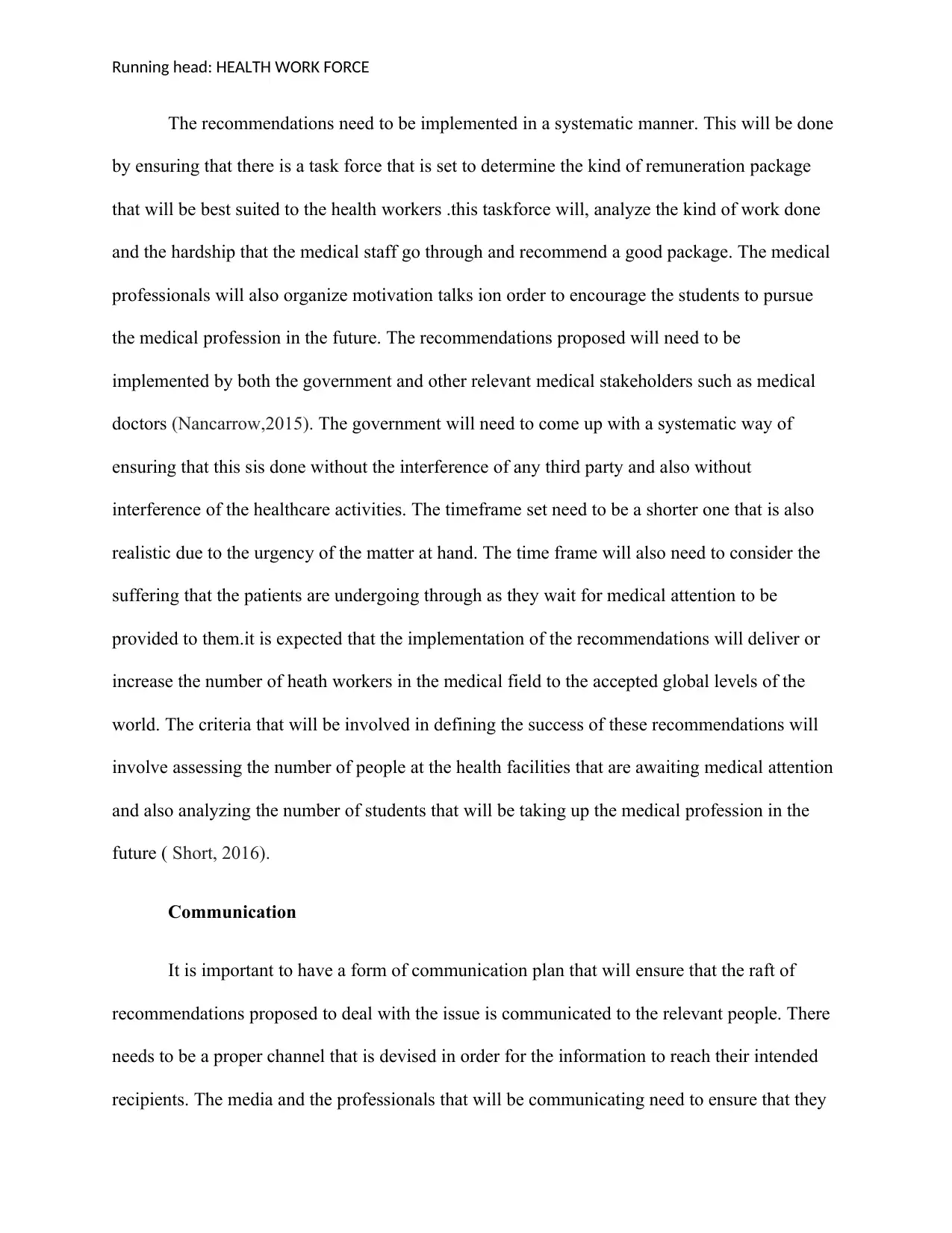
Running head: HEALTH WORK FORCE
The recommendations need to be implemented in a systematic manner. This will be done
by ensuring that there is a task force that is set to determine the kind of remuneration package
that will be best suited to the health workers .this taskforce will, analyze the kind of work done
and the hardship that the medical staff go through and recommend a good package. The medical
professionals will also organize motivation talks ion order to encourage the students to pursue
the medical profession in the future. The recommendations proposed will need to be
implemented by both the government and other relevant medical stakeholders such as medical
doctors (Nancarrow,2015). The government will need to come up with a systematic way of
ensuring that this sis done without the interference of any third party and also without
interference of the healthcare activities. The timeframe set need to be a shorter one that is also
realistic due to the urgency of the matter at hand. The time frame will also need to consider the
suffering that the patients are undergoing through as they wait for medical attention to be
provided to them.it is expected that the implementation of the recommendations will deliver or
increase the number of heath workers in the medical field to the accepted global levels of the
world. The criteria that will be involved in defining the success of these recommendations will
involve assessing the number of people at the health facilities that are awaiting medical attention
and also analyzing the number of students that will be taking up the medical profession in the
future ( Short, 2016).
Communication
It is important to have a form of communication plan that will ensure that the raft of
recommendations proposed to deal with the issue is communicated to the relevant people. There
needs to be a proper channel that is devised in order for the information to reach their intended
recipients. The media and the professionals that will be communicating need to ensure that they
The recommendations need to be implemented in a systematic manner. This will be done
by ensuring that there is a task force that is set to determine the kind of remuneration package
that will be best suited to the health workers .this taskforce will, analyze the kind of work done
and the hardship that the medical staff go through and recommend a good package. The medical
professionals will also organize motivation talks ion order to encourage the students to pursue
the medical profession in the future. The recommendations proposed will need to be
implemented by both the government and other relevant medical stakeholders such as medical
doctors (Nancarrow,2015). The government will need to come up with a systematic way of
ensuring that this sis done without the interference of any third party and also without
interference of the healthcare activities. The timeframe set need to be a shorter one that is also
realistic due to the urgency of the matter at hand. The time frame will also need to consider the
suffering that the patients are undergoing through as they wait for medical attention to be
provided to them.it is expected that the implementation of the recommendations will deliver or
increase the number of heath workers in the medical field to the accepted global levels of the
world. The criteria that will be involved in defining the success of these recommendations will
involve assessing the number of people at the health facilities that are awaiting medical attention
and also analyzing the number of students that will be taking up the medical profession in the
future ( Short, 2016).
Communication
It is important to have a form of communication plan that will ensure that the raft of
recommendations proposed to deal with the issue is communicated to the relevant people. There
needs to be a proper channel that is devised in order for the information to reach their intended
recipients. The media and the professionals that will be communicating need to ensure that they
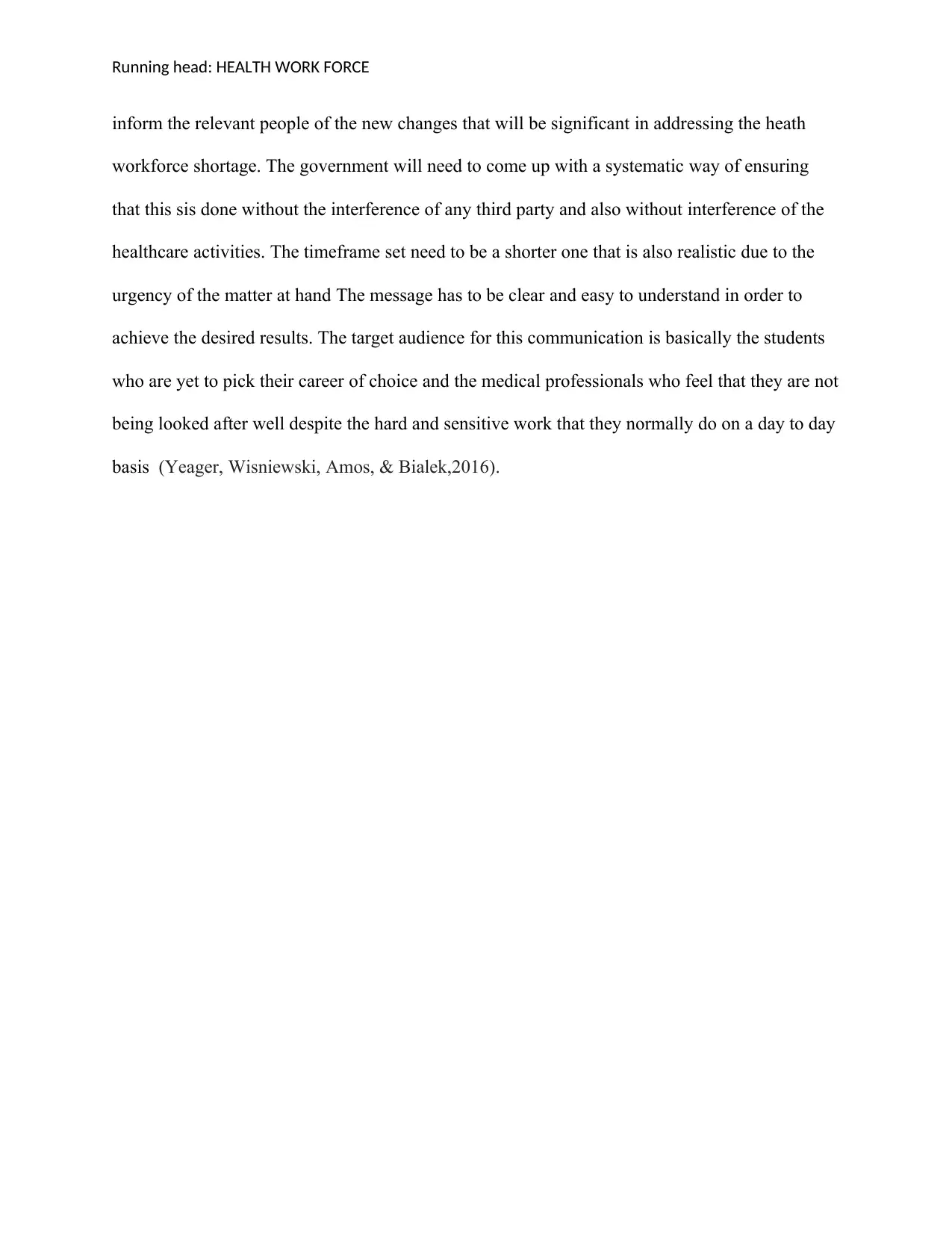
Running head: HEALTH WORK FORCE
inform the relevant people of the new changes that will be significant in addressing the heath
workforce shortage. The government will need to come up with a systematic way of ensuring
that this sis done without the interference of any third party and also without interference of the
healthcare activities. The timeframe set need to be a shorter one that is also realistic due to the
urgency of the matter at hand The message has to be clear and easy to understand in order to
achieve the desired results. The target audience for this communication is basically the students
who are yet to pick their career of choice and the medical professionals who feel that they are not
being looked after well despite the hard and sensitive work that they normally do on a day to day
basis (Yeager, Wisniewski, Amos, & Bialek,2016).
inform the relevant people of the new changes that will be significant in addressing the heath
workforce shortage. The government will need to come up with a systematic way of ensuring
that this sis done without the interference of any third party and also without interference of the
healthcare activities. The timeframe set need to be a shorter one that is also realistic due to the
urgency of the matter at hand The message has to be clear and easy to understand in order to
achieve the desired results. The target audience for this communication is basically the students
who are yet to pick their career of choice and the medical professionals who feel that they are not
being looked after well despite the hard and sensitive work that they normally do on a day to day
basis (Yeager, Wisniewski, Amos, & Bialek,2016).
⊘ This is a preview!⊘
Do you want full access?
Subscribe today to unlock all pages.

Trusted by 1+ million students worldwide
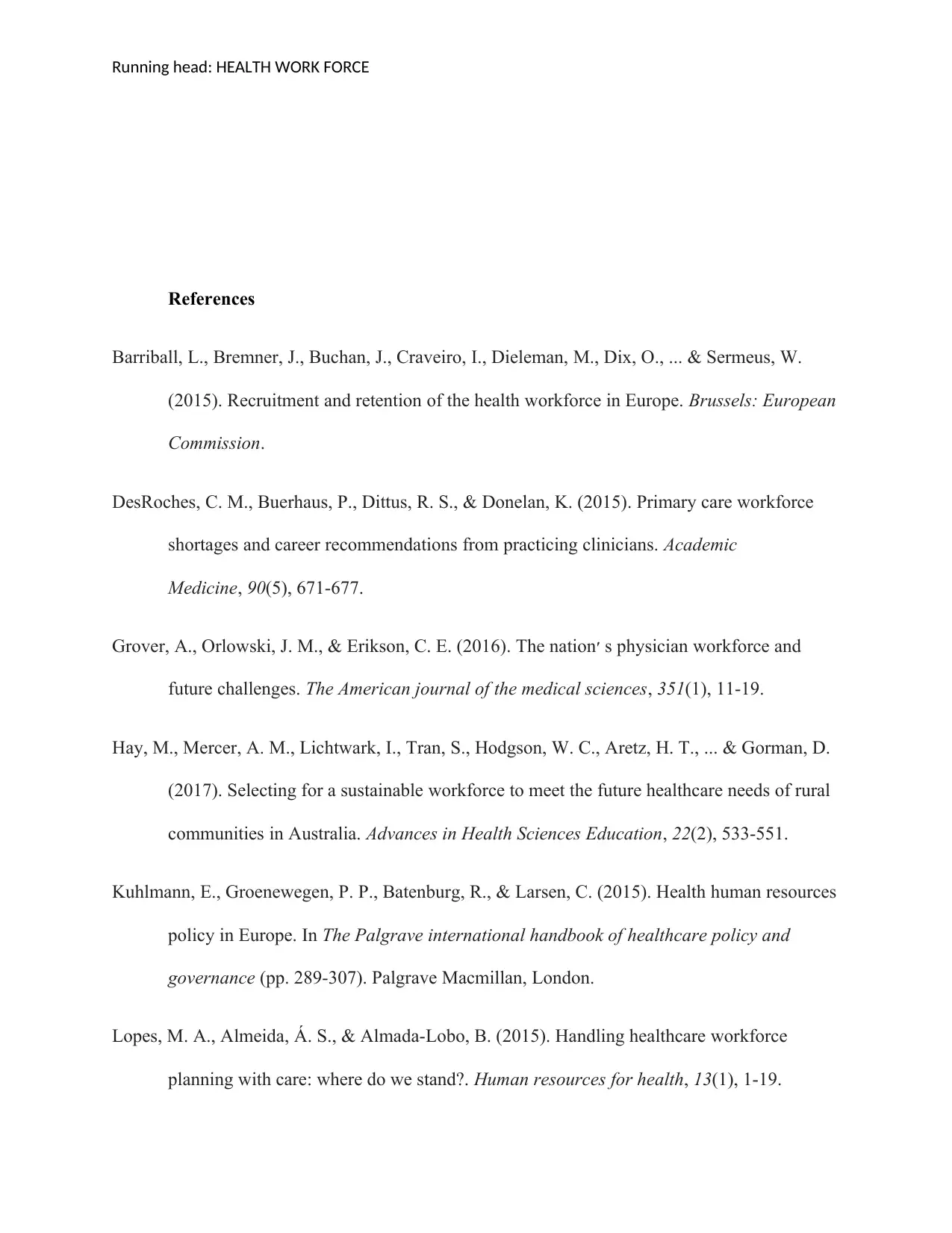
Running head: HEALTH WORK FORCE
References
Barriball, L., Bremner, J., Buchan, J., Craveiro, I., Dieleman, M., Dix, O., ... & Sermeus, W.
(2015). Recruitment and retention of the health workforce in Europe. Brussels: European
Commission.
DesRoches, C. M., Buerhaus, P., Dittus, R. S., & Donelan, K. (2015). Primary care workforce
shortages and career recommendations from practicing clinicians. Academic
Medicine, 90(5), 671-677.
Grover, A., Orlowski, J. M., & Erikson, C. E. (2016). The nation׳ s physician workforce and
future challenges. The American journal of the medical sciences, 351(1), 11-19.
Hay, M., Mercer, A. M., Lichtwark, I., Tran, S., Hodgson, W. C., Aretz, H. T., ... & Gorman, D.
(2017). Selecting for a sustainable workforce to meet the future healthcare needs of rural
communities in Australia. Advances in Health Sciences Education, 22(2), 533-551.
Kuhlmann, E., Groenewegen, P. P., Batenburg, R., & Larsen, C. (2015). Health human resources
policy in Europe. In The Palgrave international handbook of healthcare policy and
governance (pp. 289-307). Palgrave Macmillan, London.
Lopes, M. A., Almeida, Á. S., & Almada-Lobo, B. (2015). Handling healthcare workforce
planning with care: where do we stand?. Human resources for health, 13(1), 1-19.
References
Barriball, L., Bremner, J., Buchan, J., Craveiro, I., Dieleman, M., Dix, O., ... & Sermeus, W.
(2015). Recruitment and retention of the health workforce in Europe. Brussels: European
Commission.
DesRoches, C. M., Buerhaus, P., Dittus, R. S., & Donelan, K. (2015). Primary care workforce
shortages and career recommendations from practicing clinicians. Academic
Medicine, 90(5), 671-677.
Grover, A., Orlowski, J. M., & Erikson, C. E. (2016). The nation׳ s physician workforce and
future challenges. The American journal of the medical sciences, 351(1), 11-19.
Hay, M., Mercer, A. M., Lichtwark, I., Tran, S., Hodgson, W. C., Aretz, H. T., ... & Gorman, D.
(2017). Selecting for a sustainable workforce to meet the future healthcare needs of rural
communities in Australia. Advances in Health Sciences Education, 22(2), 533-551.
Kuhlmann, E., Groenewegen, P. P., Batenburg, R., & Larsen, C. (2015). Health human resources
policy in Europe. In The Palgrave international handbook of healthcare policy and
governance (pp. 289-307). Palgrave Macmillan, London.
Lopes, M. A., Almeida, Á. S., & Almada-Lobo, B. (2015). Handling healthcare workforce
planning with care: where do we stand?. Human resources for health, 13(1), 1-19.
Paraphrase This Document
Need a fresh take? Get an instant paraphrase of this document with our AI Paraphraser
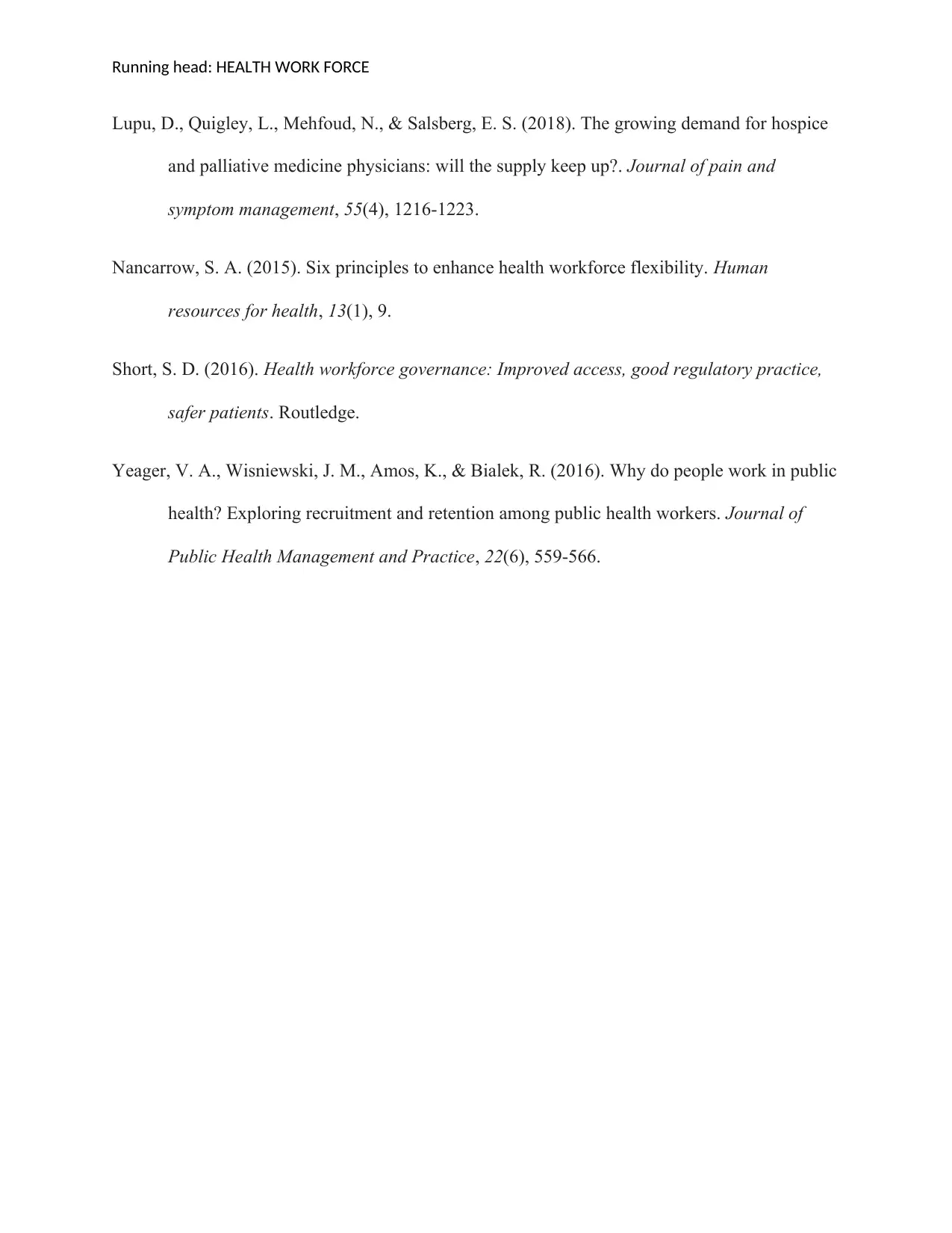
Running head: HEALTH WORK FORCE
Lupu, D., Quigley, L., Mehfoud, N., & Salsberg, E. S. (2018). The growing demand for hospice
and palliative medicine physicians: will the supply keep up?. Journal of pain and
symptom management, 55(4), 1216-1223.
Nancarrow, S. A. (2015). Six principles to enhance health workforce flexibility. Human
resources for health, 13(1), 9.
Short, S. D. (2016). Health workforce governance: Improved access, good regulatory practice,
safer patients. Routledge.
Yeager, V. A., Wisniewski, J. M., Amos, K., & Bialek, R. (2016). Why do people work in public
health? Exploring recruitment and retention among public health workers. Journal of
Public Health Management and Practice, 22(6), 559-566.
Lupu, D., Quigley, L., Mehfoud, N., & Salsberg, E. S. (2018). The growing demand for hospice
and palliative medicine physicians: will the supply keep up?. Journal of pain and
symptom management, 55(4), 1216-1223.
Nancarrow, S. A. (2015). Six principles to enhance health workforce flexibility. Human
resources for health, 13(1), 9.
Short, S. D. (2016). Health workforce governance: Improved access, good regulatory practice,
safer patients. Routledge.
Yeager, V. A., Wisniewski, J. M., Amos, K., & Bialek, R. (2016). Why do people work in public
health? Exploring recruitment and retention among public health workers. Journal of
Public Health Management and Practice, 22(6), 559-566.
1 out of 8
Related Documents
Your All-in-One AI-Powered Toolkit for Academic Success.
+13062052269
info@desklib.com
Available 24*7 on WhatsApp / Email
![[object Object]](/_next/static/media/star-bottom.7253800d.svg)
Unlock your academic potential
Copyright © 2020–2025 A2Z Services. All Rights Reserved. Developed and managed by ZUCOL.



